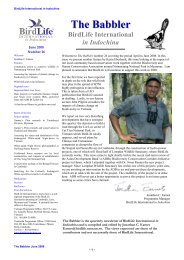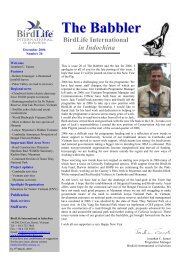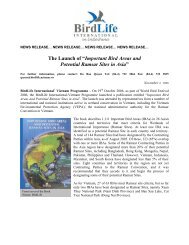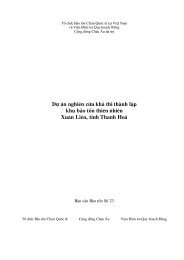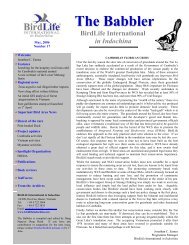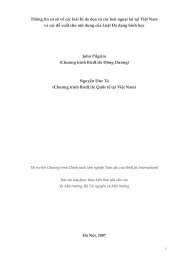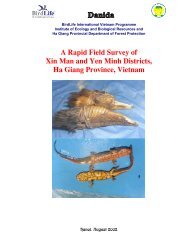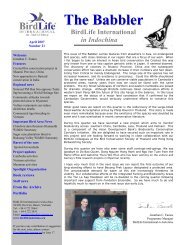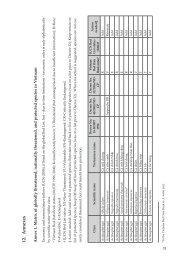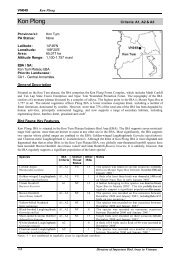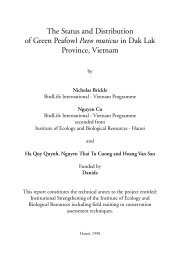Bird Life Tieng Anh-01.qxd - Birdlife International in Indochina
Bird Life Tieng Anh-01.qxd - Birdlife International in Indochina
Bird Life Tieng Anh-01.qxd - Birdlife International in Indochina
You also want an ePaper? Increase the reach of your titles
YUMPU automatically turns print PDFs into web optimized ePapers that Google loves.
and Sonobe and Usui (1993). Additional <strong>in</strong>formation on threats to biodiversity was obta<strong>in</strong>ed through<br />
<strong>in</strong>terviews with local people, border soldiers, district officials and site managers.<br />
2.3 Vegetation surveys<br />
Vegetation-type boundaries were plotted for each site and survey transects def<strong>in</strong>ed to sample all<br />
major types. Surveys were carried out by boat or on foot and methods <strong>in</strong>cluded direct observation<br />
and sampl<strong>in</strong>g of plant communities, and <strong>in</strong>terviews with local people. Photographs were taken of<br />
each vegetation type, and notes taken on plant composition and density at each location.<br />
Plant lists were compiled us<strong>in</strong>g data from a 1996 survey (Pedersen and Nguyen Huy Thang 1996).<br />
Some species were identified and marked <strong>in</strong> the field, others were photographed and dry specimens<br />
brought to Hanoi for identification by morphological comparision with literature sources (Lecomte<br />
(eds.) 1907–1937, Humbert (ed.) 1948–1950, Anon. 1972–1976, and Pham Hoang Ho 1999–2000).<br />
2.4 Site mapp<strong>in</strong>g methodology<br />
2.4.1. Materials and software<br />
1:50,000 Topographic maps.<br />
MapInfo version 6.0, Microsoft version 4.3. Garm<strong>in</strong> GPS 12Xl.<br />
Landsat TM7 Satellite Image, 2003.<br />
2.4.2. Image classification<br />
Landsat TM7 Satellite Images from 2003 were visualised and classified with each polygon coded.<br />
Habitat maps were constructed us<strong>in</strong>g the coded polygons and ground truthed us<strong>in</strong>g transects and<br />
survey po<strong>in</strong>ts. Datasheets were used to collect <strong>in</strong>formation <strong>in</strong> the field, and digital photographs were<br />
used to help construct the maps. Information on previous and chang<strong>in</strong>g land-uses <strong>in</strong> the area was<br />
obta<strong>in</strong>ed by <strong>in</strong>terview<strong>in</strong>g local people.<br />
2.4.3. GIS methods<br />
A Geographical Information System (GIS) was used to comb<strong>in</strong>e textual and spatial data. F<strong>in</strong>al<br />
habitat maps were constructed us<strong>in</strong>g the overlay and thematic mapp<strong>in</strong>g functions of MapInfo version<br />
6.0 and six maps were generated, cover<strong>in</strong>g sites between An Hai, Hai Phong city and Nghia Hung,<br />
Nam D<strong>in</strong>h prov<strong>in</strong>ce.<br />
3. Results<br />
3.1 Literature review<br />
The most comprehensive biodiversity study on the coastal wetlands of the Red River Delta was<br />
conducted <strong>in</strong> 1996 by the <strong>Bird</strong><strong>Life</strong> <strong>International</strong> Vietnam Programme <strong>in</strong> collaboration with the<br />
Forest Inventory and Plann<strong>in</strong>g Institute (FIPI). Results were presented <strong>in</strong> Technical Report No. 8<br />
of <strong>Bird</strong><strong>Life</strong> Vietnam, entitled The conservation of key coastal wetland sites <strong>in</strong> the Red River Delta<br />
(Pedersen and Nguyen Huy Thang 1996). The report identified seven key wetland sites for<br />
biodiversity conservation <strong>in</strong> the Delta; Thuy Nguyen District, Van Uc Estuary, Thai B<strong>in</strong>h Estuary<br />
(Tien Lang District), Thai B<strong>in</strong>h Estuary (Thai Thuy District), Tien Hai Nature Reserve, Xuan Thuy<br />
Nature Reserve (now a National Park) and Nghia Hung District.<br />
3




